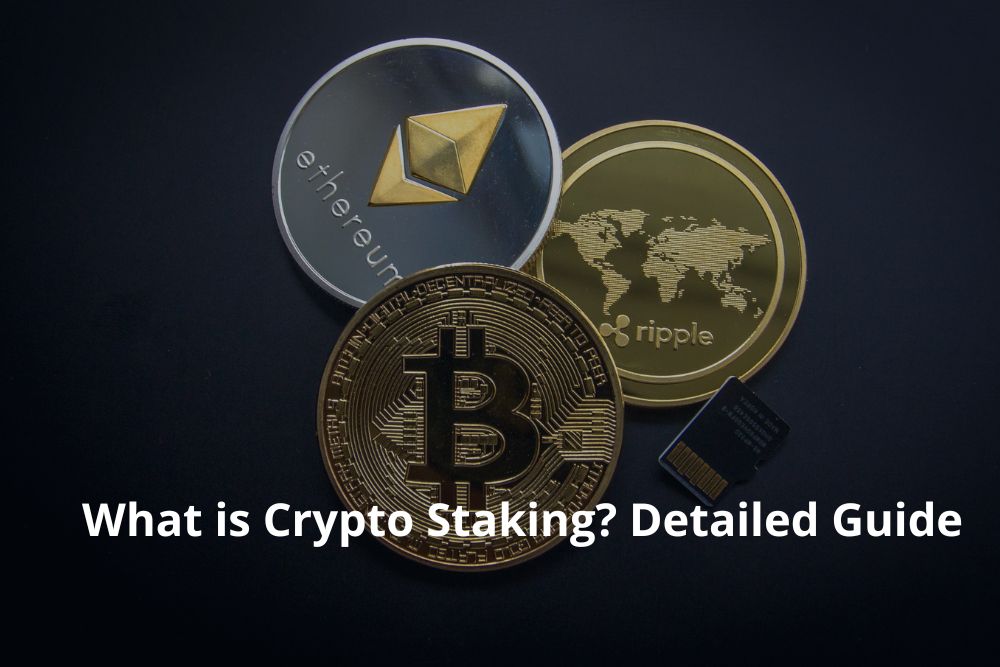What is Crypto Staking? Detailed Guide

After Compound’s token launch in June 2020, a brilliant new crypto business called Decentralized Finance (DeFi) began to gain popularity. Investors immediately turned passive ownership of their crypto assets into profitable passive income thanks to a slew of DeFi knockoff technologies.
This was made possible by the strength of smart DeFi protocols, which offered enormous rewards for individuals prepared to bet their money and entrust them to risky smart contracts. These rewards included income on investments as well as governance tokens, the value of which skyrocketed. Since then, the DeFi market cap has multiplied, and the sector has continued to develop, even competing with the TradFi field.
As returns began to decline in 2021 and the DeFi market mainly lost ground to NFTs, the new kid on the block, savvy investors began to see new passive income options that, by the end of the year, offered significant protection against the waning crypto markets. Although the NFT industry is still young and emerging new industries like Web 3.0 and the Metaverse are still more hype than anything else, DeFi has a track record of success in assisting investors in maximising their cryptocurrency returns.
What Is Crypto Staking?
When a user engages in staking, they lock or retain their cryptocurrency in a wallet in order to support the upkeep of a proof-of-stake (PoS)-based blockchain system. It is comparable to cryptocurrency mining in that it promotes network consensus while rewarding active users.
In staking, the number of coins that are “locked” in a wallet determines who has the power to validate transactions. Stakers are rewarded for adding a transaction or discovering a new block on a blockchain, similar to mining on a PoW network. In addition to incentives, PoS blockchain networks provide excellent transaction speeds and are scalable.
How Does Proof-of-Stake Work?
In a blockchain network, the proof-of-stake (PoS) consensus process makes use of validators to check transactions and uphold consensus. Users are encouraged by the network to operate validator nodes and stake their currencies, which contributes to the network’s security in exchange for interest on their stake.
Depending on the protocol, PoS systems operate differently, but in general, the algorithm selects blocks at random and sends them to a validator node for inspection.
The validator then examines the transactions’ authenticity. If everything is correct, the block is added to the ledger and the validator gets paid the transaction fees and block rewards. But if a validator adds a block with incorrect information, its staked holdings will suffer.
PoS is renowned for having more energy efficiency than PoW, reduced entry barriers, and better scalability. In fact, shard chains, one of the most promising scaling solutions to date, are supported more strongly under the Ethereum PoS architecture.
Mining vs Staking
The underlying blockchain consensus process used to validate transactions is the primary distinction between mining and staking. Most notably in BTC, mining is utilised for Proof-of-Work (PoW). Staking, on the other hand, is mostly utilised for Proof-of-Stake (PoS), as seen in Ethereum 2.0, which saw Ethereum switch from a PoW to a PoS consensus method.
Some of the distinctions between mining and staking include the following:
- In contrast to Staking, which nodes in the network use to validate new blocks by locking up their funds. Mining involves solving challenging mathematical riddles.
- A block is added to the blockchain by the first miner to solve the mathematical challenge. As opposed to staking, where nodes verify a new block by securing native tokens in a smart contract.
- compared to Staking, which is generally thought to be more environmentally beneficial. And saves over 99 percent of energy use, requires specialised mining hardware (such as a GPU) which uses a lot of energy.
- More computational power (work), compared to staking. Which involves putting more native tokens up for stake (stored value), increases the likelihood of being chosen to validate fresh blocks.
What Can I Stake?
Staking chances abound in 2022 on cryptocurrency exchanges like Binance, Coinbase, and FTX as well as directly on the native wallets or specialized hardware wallets of particular blockchains. Here are some of the top ones. There are other other options to take into account, including Funex, Avalanche, and Solana.
Cold or Private Wallets
Cold staking is another name for this type of staking. To avoid losing staking incentives due to shifting stacked coins during the lock-up period, a staker must retain their stacked coins in the same address.
Leading offline/private cryptocurrency wallets supporting staking include:
- Ledger – In terms of cold wallets, Ledger is the market leader. Hardware wallets have the benefit of allowing you to continue to have complete control over your funds during a staking session. Ledger offers consumers the option to stake up to seven coins in addition to its security. Tron (TRX), ATOM, and ALGO are a some of the coins it supports for staking.
- Trust Wallet – Binance supports the adaptable Trust Wallet, a personal wallet. By staking XTZ, ATOM, VeChain (VET), TRX, IoTeX (IOTX), ALGO, users of the wallet can get passive income (CLO).
- CoolWallet S– Through its X-Savings feature, the first Bluetooth mobile hardware wallet CoolWallet S provides stablecoin (USDT) staking in-app.
- Trezor – The oldest hardware wallet in the world allows users to stake certain assets like Tezos using third-party applications like the Exodus wallet.
How to Choose a Crypto Staking Platform
Choose your crypto staking site carefully before rushing to stake your coins. The benefits are just as significant. You could completely lose your awards and stacked coins if you make the wrong decision. Following are some suggestions for selecting a staking platform:
- Never accept a founder’s or team’s word for any protocol they are attempting to implement when it comes to new DeFi platforms, especially if you are not technically savvy. Check out Twitter and Reddit to see what people are saying about the protocol. Dev users are typically able to detect potential rug pulls and will typically warn the community. If they discover any indications of wrongdoing or a coding vulnerability.
- Avoid obsessing with annualised rewards or APYs. There are numerous more important elements to take into account, such as the platform’s reputation and age.
- Stick as much as you can to trusted platforms like Maker, Cool Wallet, etc. Rather than gambling your cryptocurrency riches on dubious-looking platforms that guarantee astronomically large staking yields.
- Utilize trustworthy analytics, like CoinMarketCap, to verify data on a PoS-based platform. This also holds true for platforms that offer staking as a service and independent staking services.
- Read the criteria and guidelines, or the rules controlling the staking process, before you stake. The rules address issues such as whether the wallet must be online constantly. Whether staked cryptocurrency must pass through a cooling off period before being unstaked, as well as a minimum staking value.
The Future of Crypto Staking
Prepare, set, and stake. It is obvious from the discussion above that staking is better for the environment. And maybe better for the economy than mining using the PoW algorithm. As a result, it is justifiably gaining momentum and a bigger proportion of the crypto market.
When Ethereum eventually made the change and formally welcomed staking in December 2020, the shift toward staking gained additional strength.
Last but not least, caution should be exercised when engaging in DeFi staking, despite its FOMO-inducing growth. Particularly when using freshly developed protocols that promise suspiciously high returns for yield farmers or liquidity providers.
Keep in mind that investing in cryptocurrencies has a considerable risk, so careful planning and study are a must. Enjoy your stake!




